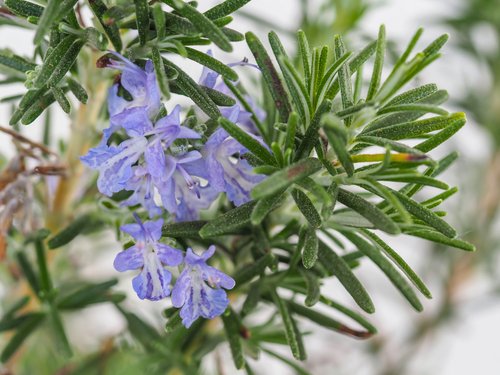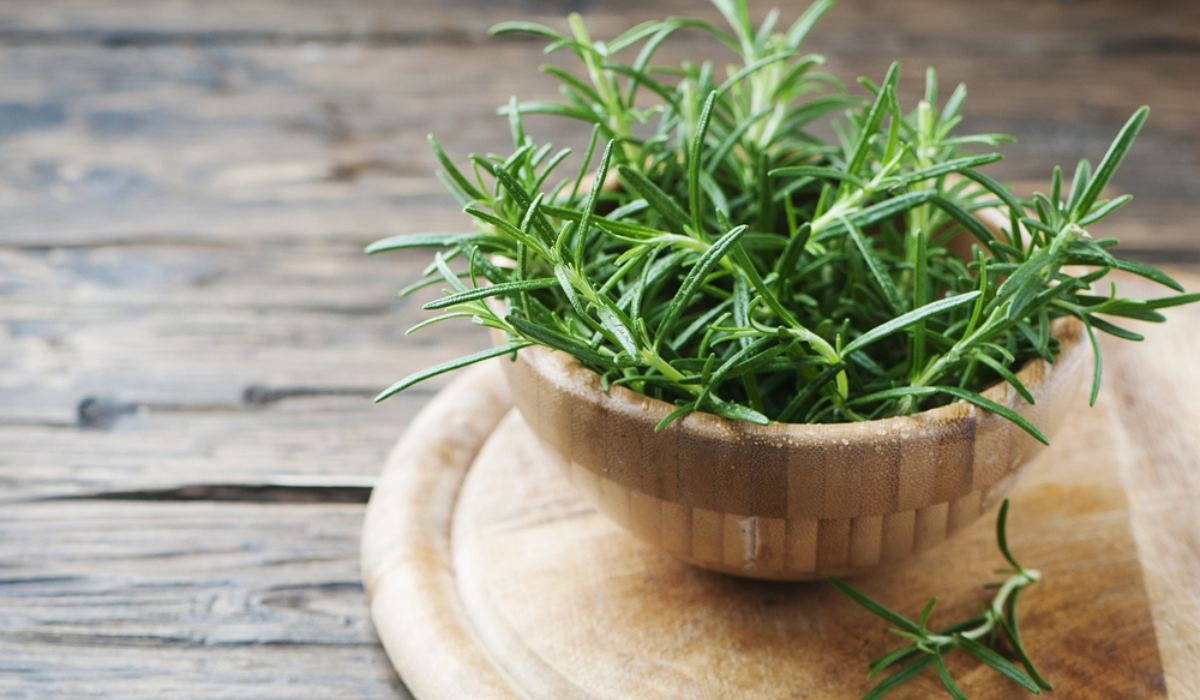The Rosemary plant, also known as Salvia Rosmarinus, is a Mediterranean-based shrub with needle-like leaves and flowers of different colours. Before 2017, it took off by the biological term Rosmarinus officinalis. It is owned by the Lamiaceae sage family, comprising several other culinary and medicinal plants. Latin Ros marinus is where the term rosemary originates (dew of the sea). The root system of a rosemary plant is fibrous.
Rosemary plant has leaves identical to hemlock needles. However, it is aboriginal to Asia and the Mediterranean, and it can prevail in cold climates. It can survive severe water shortages over extended periods during droughts. It is advised to buy the plant instead of starting the seeds because it can live up to 30 years and has a low germination rate and slow development. The colour of a rosemary flower is blue.
know all about White Fly
What is Rosemary: Physical Description
Rosemary is a perennial shrub and typically grows to a height of nearly 3.3 feet, though some plants can grow up to a height of 2 metres. It has linear leaves, which are around 1 cm long and look like small curved pine needles. These leaves are dark green and shiny with curled leaf margins and a white underside. Rosemary bears small bluish flowers in axillary clusters. These flowers are quite attractive to bees.
see also: New year rose
Types of Rosemary

- Prostratus: This cultivar grows slowly and widely, reaching heights of around two feet and widths of two to three feet.
- Golden Rain: This plant has golden patterns on its leaf and stays compact at two to three feet high and broad.
- Albus: This cultivar is distinguished by its white blossoms.
- Arb: This plant is renowned for its ability to withstand freezing temperatures and has light green leaves with a lemony aroma.
When is Rosemary in season?
Rosemary is an evergreen plant and can be harvested anytime during the year. However, it’s advisable to harvest it in the summer for the best flavour. As for growing it, the best time to plant rosemary is in the spring season.
How to plant Rosemary?
Although it is possible to produce Rosemary from seed, germination speed is usually low, and the development of seedlings is slow. Starting new rosemary plants from pruning developed plants is highly recommended. In exceptional circumstances, cuttings grow fast and must be ready for outdoor cultivation in around eight weeks.
- When to plant? The optimum time to plant Rosemary is in the spring when it has warmed up, and there is no chance of frost. In general, you may start indoor containers at any time of year.
- Location: Rosemary thrives in a sunny location with sharply draining soil. Make sure there aren’t any nearby more giant trees or plants that may shadow the Rosemary. A Rosemary plant may flourish indoors or outdoors in pots if given adequate light.
- Depth, support, and spacing: Plant your rosemary bushes at least two to three feet apart. The depth they grew in their previous container should be used to sow seedlings and nursery plants. When sowing, the earth should barely cover the seeds. Usually, this shrub doesn’t need a support structure.
Rosemary Plant Care
Soil
Rosemary plant grows well in sandy or loamy soil that drains well. It struggles to thrive in moist, thick clay soils. The optimal soil pH ranges from mildly acidic to neutral (6.0 to 7.0).
Light
Rosemary prefers direct sunlight and cannot tolerate shade. This implies that it needs at least six hours of direct sunshine on most days. A south-facing window is best for indoor development, although grow lights are frequently required to supplement natural light. When it’s nice outside, take the rosemary plant out so they can get some sunlight. Leggy and feeble development may result from inadequate lighting.
Humidity and temperature
Warm temperatures and average humidity levels are ideal for a rosemary plant. Most rosemary types have strong heat tolerance but cannot tolerate temperatures below 30 degrees. They love environments that are between 55 and 80 degrees. High humidity can also cause rot and fungal problems, mainly if there is insufficient air circulation around the plant.
Water
Once established, rosemary bushes can withstand drought well; thus, it is preferable to drown them instead of overwatering them. Let the top few inches of soil dry out between waterings, and then water to moisten evenly but not flood the soil.
Pollination
In addition to self-pollinating, rosemary plants draw bees and pollinators to the garden. When the weather is excellent, and the flowers are open, take indoor plants outside so pollination can occur spontaneously.
Fertilisers
Rosemary doesn’t eat a lot. Compost added to the soil when planting could help the shrub get off to a good start—after that, using a balanced liquid fertiliser as directed on the package will keep encouraging quality growth.
Pruning
Once the rosemary plant has finished flowering, prune it as needed to control its growth. Rosemary flowers may be trained into topiary forms and respond well to trimming. However, avoid removing more than a third of the plant at once since doing so may stress the rosemary flowers and make them more susceptible to pests and diseases.
How to grow Rosemary from cuttings?
The best course of action if you want to multiply your rosemary plant is to start with a cutting. Taking cuttings from an established plant saves money on buying new plants and encourages bushier, more branched growth. The spring or summer months are the ideal times to take a cut.
- Cut a stem that is a few inches long and healthy. For optimal results, choose new softwood growth.
- Leave at least five leaves on the stem after removing the leaves from the lowest section.
- Inject rooting hormone into the cut end.
- Plant the cutting in a damp soilless potting mix in a little container with drainage holes.
- Put the container in a cozy area with good indirect light. Ensure the growth medium doesn’t dry out, and mist the cutting daily.
- Check for roots by gently pulling on the stem for two to three weeks. Resistance is a sign that roots have taken hold. The cutting is then prepared for transplantation.
How to grow Rosemary from seeds?
Because rosemary seeds are difficult to germinate and frequently do not grow true to their parent plant, growing rosemary from sources may be challenging. Plant many more rosemary seeds than the number of plants you want to develop if you attempt growing it from seed. Plant seeds about three months before your region’s anticipated spring last frost date. Do the following:
- Place the seeds in a tray with a damp seed-starting mix, covering them a little.
- To keep the mixture from drying out, cover the tray with plastic wrap to keep moisture in.
- To maintain the soil between 80- and 90 degrees Fahrenheit, place the tray on a heating pad.
- When seedlings start to appear, take the plastic wrap off and set the tray in a bright area.
- Move seedlings to individual pots or, if the weather is nice until they are about 3 inches tall.
Rosemary: Pests and diseases

Causes of pests and diseases
- The excess moisture frequently causes Rosemary illnesses on the leaves or in the soil
- Powdery mildew and rotting of root and crown, two ailments brought on by an abundance of moisture, frequently affect rosemary plants.
- If the situation isn’t changed, crown rot and root will destroy the plant, causing dieback in the hearts and stem. It happens when rosemary is farmed in clay soil that drains slowly.
- The best action is to plow the rosemary and shift it to an appropriate location or put it in a jar where extra moisture may drain.
- Issues with a rosemary plant might also result from improper irrigation. When rosemary foliage absorbs excess water, usually because of excess moisture, rosemary powdery mildew develops. As a result, a granular white material develops on the leaves.
- It is irregular to discover spider mites or thrips on rosemary; however, it may periodically lure aphids and whiteflies. Pests are more commonly found on indoor rosemary flowers than on outdoor plants.
- Whiteflies occupy rosemary leafage, developing thick clumps with their faded bodies. Petty whitefly infestations induce severe crises. In addition, these crises must be dealt with manually before they reproduce.
- Advanced infestations need rosemary plants to be tossed out completely.
Prevention of pests and diseases
- The greatest form of management of pests and illnesses that affect a rosemary plant is prevention. Rosemary thrives on stony, rapidly draining soil that is poor in fertility.
- Affluent, rich soil should be avoided since it increases the probability of root issues. In locations with dense soil, especially in environments with significant summer rains and extreme humidity, it is always preferable to grow rosemary in pots.
- Additionally, picking a growing place with whole light, sufficient circulation, and a climate that allows the leaves to dry fast after becoming wet is always preferable.
- The correct cultural habits will also support the continued health of rosemary. During the summer, give conventional rosemary only a little water, and always let the soil get completely dry in between applications.
- Rosemary flowers thrive in nutrient-poor soil and perform well with mild fertilizer treatments if the ground is formed of sand, decomposed granite, or another nutrient-deficient soil.
- During the summer, give rosemary a monthly feeding of one-fourth teaspoon fertilizer mixed with one gallon of water. If succulent growth appears after providing the plant, stop feeding the rosemary plant.
Rosemary medicinal uses
- Rosemary plants have an element of powerful antioxidant impact known as carnosic acid. It has existed in analyses that chances to reduce the formation of tumors have increased and to decrease the development of cancer cells in the body.
- Studies have shown the effective antiviral, antibacterial, and antifungal effects of rosemary’s rosmarinic and carnosic acids. Regular use of rosemary may lessen body infections and boost the immune system’s ability to fight off any bacterial or viral infections that may develop.
- Preliminary studies suggest that a rosemary plant has a beneficial effect in lowering anxiety and tension, while additional research is required. In a randomized experiment involving college students, rosemary was found to promote better sleep and reduce stress more than a placebo.
- Studies in aromatherapy using rosemary flowers have supported some of the assertions that rosemary has been used for ages as a memory help. One research indicated that breathing rosemary essential oil significantly improved cognitive function within 20 minutes.
- Rosemary is rich in phytochemicals. Although vitamins and minerals are necessary for living, phytochemicals are still crucial for preventing illness and maintaining general health.
Rosemary Culinary Uses

- While rosemary pairs nicely with other herbs, you should only use a small amount of it on its own in meals with lamb, hog, chicken, and veal, as well as in soups, stews, vegetables, and sauces.
- Rosemary adds a lovely flavor to bread and works well in marinades with garlic, wine, and olive oil.
- The fragrant properties of rosemary flowers also improve a bath, bouquet, wreath, or sachet.
Rosemary: Toxicity
In the right amounts, rosemary is not a toxic plant. However, in excess quantities, rosemary essential oil can be toxic.
Conclusion
In most cases, the rosemary plant requires little maintenance, although poor growing conditions and maintenance might make it vulnerable to disease and insect infestations. While many common problems with rosemary may be resolved if discovered early, others can weaken and ultimately kill the plant if not handled.
FAQs
Does rosemary return every year?
The Rosemary plant is an evergreen perennial with a long lifespan within its hardiness range.
Is it simple to cultivate rosemary?
If it receives enough light, warmth, and soil drainage, rosemary may thrive easily.
How long does it take rosemary to grow?
A rosemary plant reaches its full size and starts to bloom during the second growing season.
Housing News Desk is the news desk of leading online real estate portal, Housing.com. Housing News Desk focuses on a variety of topics such as real estate laws, taxes, current news, property trends, home loans, rentals, décor, green homes, home improvement, etc. The main objective of the news desk, is to cover the real estate sector from the perspective of providing information that is useful to the end-user.
Facebook: https://www.facebook.com/housing.com/
Twitter: https://twitter.com/Housing
Email: [email protected]











